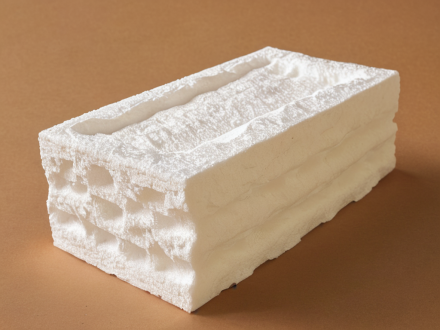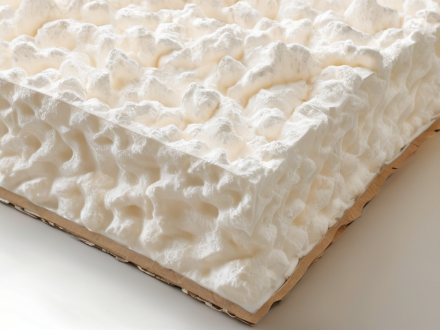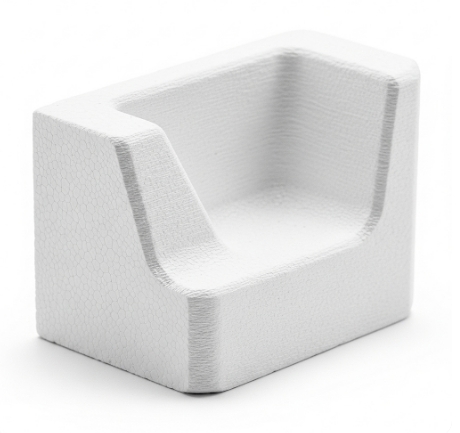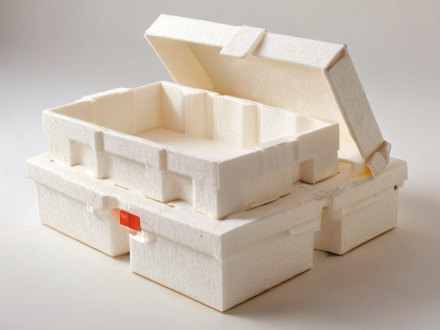Polystyrene: Definition, Features, Types and Applications
Polystyrene, a highly versatile plastic material, serves essential roles across industries. But what are polystyrene’s unique benefits and uses? Many know polystyrene as a material for cups, packaging, and insulation, but it is also found in more specialized applications across automotive, medical, and consumer electronics.
Polystyrene is a lightweight, durable thermoplastic, widely used in solid and foam forms for insulation, packaging, and product manufacturing due to its affordability and versatility. Its forms and properties make it one of the most important polymers used today.
Let’s explore polystyrene’s definition, types, features, and applications across industries, and uncover its environmental impact and sustainable solutions for the future.
What is Polystyrene?
Polystyrene, commonly referred to as “PS plastic,” is a polymer that originates from the polymerization of styrene monomers. These monomers are derived from by-products of petroleum or natural gas and undergo chemical manipulation to create long polymer chains. The material is noted for its lightweight nature, durability, and low production costs, which contribute to its significance in a wide range of industries.
Polystyrene is a synthetic thermoplastic that is primarily utilized in both solid and foam forms. This includes well-known products such as Styrofoam, disposable cutlery, protective packaging, and PS plastic sheets. Solid polystyrene exhibits rigidity and transparency, while the foam variant is notably recognized for its lightweight and insulating characteristics.

Features of Polystyrene
Why is polystyrene so widely used? The widespread use of polystyrene can be attributed to its unique combination of properties that contribute to its versatility. As a thermoplastic, polystyrene softens at specific temperatures, enabling it to be molded or reshaped and subsequently solidified upon cooling, which makes it highly advantageous for mass manufacturing processes. Furthermore, polystyrene exhibits excellent thermal insulation, is chemically inert, and possesses resistance to bacterial growth, rendering it particularly suitable for applications in food packaging and the medical field.
Polystyrene presents excellent rigidity, a lightweight composition, low moisture absorption, and notable insulating properties, all of which enhance its suitability for packaging and insulation applications. The molecular structure of polystyrene imparts strength-to-weight ratios that contribute to its durability, flexibility in design, and efficiency in production.
Types of Polystyrene
From foam sheets to solid applications, polystyrene types are designed to meet specific needs, each with unique properties. Due to its adaptability, polystyrene is produced in several forms to serve different applications, with common types including general-purpose polystyrene (GPPS), high-impact polystyrene (HIPS), expanded polystyrene (EPS), and extruded polystyrene (XPS). Each of these types provides unique benefits for specific applications.
- General-Purpose Polystyrene (GPPS): GPPS is a hard, transparent, and brittle material, typically used for products that require clarity and rigidity, such as food containers, laboratory equipment, and packaging for delicate items.
- High-Impact Polystyrene (HIPS): HIPS is produced by adding rubber to polystyrene, making it stronger and less brittle than GPPS. HIPS is opaque and often used in applications where higher impact resistance is required, such as in refrigerator liners, vending machine cups, and electronic housings.
- Expanded Polystyrene (EPS): Known as “polystyrene foam,” EPS is a lightweight, low-density material made by expanding polystyrene beads with steam. EPS is commonly used in construction for insulation panels, packaging for fragile items, and protective inserts for helmets due to its shock-absorbing qualities.
- Extruded Polystyrene (XPS): Similar to EPS, XPS is manufactured in sheets or blocks but has a more uniform structure, making it stronger and more moisture-resistant. XPS is used for construction insulation, waterproofing applications, and as an alternative to EPS where more rigidity is required.
Which Machining Technologies are Suitable for Polystyrene Products?
Several processing technologies are suitable for producing polystyrene products, each chosen based on the intended application and the desired material properties. These technologies allow for the creation of solid, foam, and molded polystyrene products with diverse functionalities. Here are some of the main processing methods:
| Technology | Process Description | Common Applications | Key Advantages |
|---|---|---|---|
| Injection Molding | Melted polystyrene is injected into a mold under high pressure and cooled to form a shape. | Containers, consumer goods, medical devices, automotive parts | High precision, fast production, low waste |
| Extrusion | Molten polystyrene is pushed through a die to form continuous shapes, then cooled. | Sheets, films, insulation, packaging, construction profiles | Consistent shapes, continuous production |
| Blow Molding | Heated polystyrene is inflated in a mold to form hollow shapes. | Bottles, toys, food and beverage containers | Lightweight, cost-effective hollow products |
| Thermoforming | Heated PS sheets are molded using vacuum or pressure, then cooled. | Trays, clamshells, blister packs, custom packaging | Ideal for thin-walled, short-run custom parts |
| Compression Molding | Polystyrene is compressed in a heated mold to form parts, then cooled and ejected. | Electrical housings, automotive panels, industrial parts | Good for large, simple parts with fine finishes |
| Foaming (EPS) | A blowing agent is used to expand polystyrene into foam, often in molds or extrusion. | Insulation panels, protective packaging, lightweight shipping materials | Excellent insulation, lightweight, shock absorption |
| Casting | Liquid polystyrene is poured into a mold and allowed to solidify into final shape. | Prototypes, sculptures, decorative items, low-volume precision components | High detail, suitable for low-volume production |
What are the Advantages and Disadvantages of Polystyrene?
Like any material, polystyrene has its advantages and limitations, influencing where and how it’s applied. While it is highly adaptable and economical, some of its characteristics present challenges, especially regarding environmental impact.

Advantages of Polystyrene
- Cost-Effectiveness: Polystyrene is an inexpensive material, making it a popular choice for mass production, especially in disposable products like cutlery, cups, and packaging materials.
- Ease of Production: It is easy to mold and shape, which allows for the creation of complex shapes and designs quickly, reducing production times and costs.
- Lightweight: Polystyrene, particularly in its foam form (EPS), is lightweight, making it ideal for packaging, insulation, and transportation of delicate goods.
- Chemical Stability: It is chemically stable and resistant to many chemicals, which makes it a safe material for food packaging and medical applications, as it doesn’t react with food or medications.
- Insulation Properties: Expanded polystyrene (EPS) is an excellent insulator, often used in construction for thermal insulation, reducing energy costs in buildings.
Disadvantages of Polystyrene
- Environmental Impact: One of the main drawbacks of polystyrene is its non-biodegradability. It can persist in the environment for hundreds of years, contributing to plastic pollution, especially in the ocean.
- Recycling Challenges: Polystyrene, especially in foam form (EPS), is difficult to recycle. The process of recycling it is not as efficient as other plastics, and it is often discarded as waste, contributing to environmental damage.
- Brittleness: Polystyrene can be brittle, especially in its solid form, making it prone to cracking or breaking under stress. This limits its use in some structural applications where higher durability is required.
- Limited Durability: While versatile, polystyrene may not be the best choice for long-term products that need to withstand wear and tear or extreme environmental conditions.
Why Does Polystyrene Have Low Density?
Polystyrene’s low density is one of its most significant advantages, particularly in its foam form, expanded polystyrene (EPS). This low density is achieved by incorporating air-filled cells within the material’s structure during the manufacturing process. The air trapped inside these cells significantly reduces the overall weight of the material, making it extremely lightweight without compromising its strength or durability.

What are the Applications of Polystyrene?
Polystyrene’s unique properties lend it to numerous industrial and commercial applications, from product packaging to construction materials. Its ability to be manufactured in both solid and foam forms makes it one of the most versatile materials available, capable of meeting a wide range of needs.
- Insulation: Polystyrene foam, especially expanded polystyrene (EPS), is commonly used in insulation for buildings due to its excellent thermal properties and lightweight nature, helping to reduce energy consumption.
- Packaging: EPS foam is widely used for protective packaging of fragile items such as electronics and glassware. Its shock-absorbing properties help protect products during transport.

- Disposable Cutlery and Food Service: Polystyrene’s non-toxic and chemically stable characteristics make it popular in the food industry. It is used to make disposable food containers, drink cups, plates, and utensils that are both lightweight and cost-effective.
- Electronics Housing: Polystyrene’s rigidity and ease of molding make it ideal for electronic device casings and components, as it provides both structural support and protection.
- Medical Supplies: Polystyrene’s chemical stability and ease of sterilization make it suitable for medical applications, including laboratory equipment, petri dishes, and other disposable medical products.
- Food Packaging: Its stability and non-reactive nature allow polystyrene to be used safely in food packaging, keeping food fresh while providing insulation and protection.
In Conclusion
Polystyrene’s versatility, lightweight nature, and durability indeed render it invaluable across a wide range of industries, from packaging to construction and beyond. However, despite its numerous advantages, environmental sustainability remains a crucial concern, necessitating ongoing efforts to develop more eco-friendly alternatives or recycling methods to mitigate its impact on the environment.
Initiate your part processing project with VMT, a professional CNC manufacturer. We offer an extensive array of CNC machining services that cater to a wide variety of needs. From precision CNC manufacturing to sheet metal processing, we can provide tailored solutions for your specific fabrication requirements. If you have a design project that necessitates part manufacturing and production, please reach out to our team.
Frequently Asked Questions About Polystyrene
Is Polystyrene the Same as Styrofoam?
No, polystyrene and Styrofoam are not the same. Polystyrene is a type of plastic that can be solid or foamed, and it’s used widely in products like containers and packaging materials. Styrofoam is a trademarked brand of foamed polystyrene, often used for insulation and food containers, but not all foamed polystyrene is considered Styrofoam.
Is Polystyrene a Hard or Soft Plastic?
Polystyrene can be both hard and soft. The solid form of polystyrene is rigid and brittle, commonly used in items like CD cases. The foam form, often seen in packaging and insulation, is lighter and has more flexibility but can still break under pressure.
Is Polystyrene the Same as PVC?
No, polystyrene and PVC (polyvinyl chloride) are different types of plastic. Polystyrene is lighter, more brittle, and commonly used in food packaging and insulation. PVC is stronger, flexible, and used in pipes, medical devices, and flooring. They differ in properties, applications, and chemical composition.
At What Temperature Will Polystyrene Melt and Burn?
Polystyrene typically begins to melt around 100°C (212°F) and can ignite and burn at higher temperatures, approximately 427°C (800°F). At these higher temperatures, polystyrene can release toxic fumes, so it should be handled carefully when exposed to heat.
Does Polystyrene Burn or Melt?
Polystyrene melts at lower temperatures but will burn at higher temperatures. When ignited, polystyrene burns with a bright flame and produces smoke, including potentially harmful gases like carbon monoxide.



